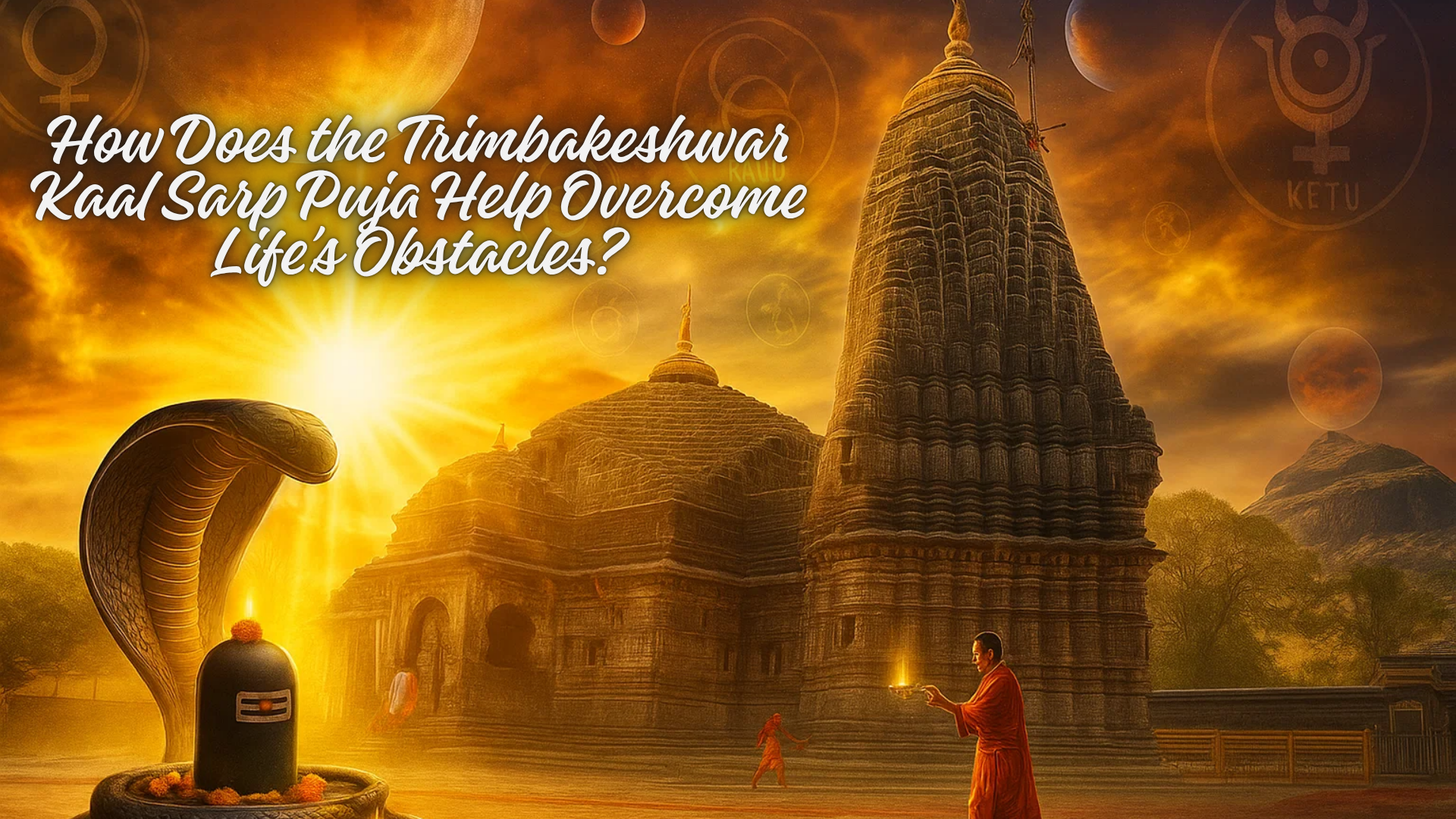How Does The Trimbakeshwar Kaal Sarp Puja Help Overcome Life’s Obstacles?

The Kaal Sarp Dosh can affect a person's life in many ways- mentally, financially, emotionally, and spiritually. This dosh, according to Vedic astrology, is believed to occur when all seven major planets are hemmed between Rahu and Ketu, the lunar nodes.
One of the most respected and spiritually charged locations to perform rituals to alleviate this dosh in Trimbakeshwar, a sacred town in Maharashtra known for its ancient temple and spiritual potency.
The Effects of Kaal Sarp Dosh
People afflicted by this dosh often report facing continuous obstacles in life, delayed success, emotional instability, and strained relationships. While not everyone may experience all symptoms, its influence is often powerful enough to affect various aspects of life. It is believed to stem from karma and unresolved ancestral issues, and the impact may continue unless appropriate remedies are performed.
Kaal Sarp Dosh is not necessarily a lifelong condition, but its effect can be prolonged if not addressed through proper rituals. There are several types of Kaal Sarp Dosh: Anant, Kulik, Vasuki, Shankhpal, and Padma, among others, depending on the planetary placements in the natal chart. Performing the Trimbakeshwar Kaal Sarp Puja is considered one of the most effective remedies to neutralize these doshas and restore balance in one’s life.
Why Trimbakeshwar Is a Preferred Location for the Puja
Nestled near the Brahmagiri Hills, Trimbakeshwar is one of the twelve Jyotirlingas, making it a highly sacred site in Hinduism. It holds an extraordinary spiritual significance because of its natural energy vortex. The location is often associated with spiritual cleansing and ancestral rites, making it ideal for addressing doshas rooted in karma and lineage.
Trimbakeshwar’s spiritual atmosphere provides the ideal setting for performing energy-transforming rituals. It is also believed that performing pujas at this location yields faster and more potent results, as the temple is a convergence point for divine energies.
Ritual Process and What It Involves
The process starts by identifying the specific type of dosh through an analysis of the person's astrological chart. The kaal sarp dosh puja is usually conducted over three hours and includes a sequence of Vedic rituals:
-
Sankalp (Resolution): A priest helps the devotee take a solemn vow, explaining the purpose and invoking the blessings of the deities.
-
Ganesh Puja: To eliminate obstacles, Lord Ganesha is worshipped first.
-
Kalash Sthapana: Establishing sacred pots symbolizing divine energies.
-
Invocation of Rahu and Ketu: Specific mantras and offerings are made to pacify these celestial entities.
-
Pitra Dosh Nivaran (Ancestral Peace): Special rites are also performed to seek blessings from forefathers and alleviate karmic debts.
-
Homam (Fire Ritual): Offerings are made into the sacred fire, invoking divine grace to neutralize malefic effects.
It is essential to follow the procedure precisely, as per Vedic traditions. The entire ceremony is carried out by well-experienced Brahmin priests trained in ancient rituals and mantras.
Significance of the Puja in a Devotee’s Life
There is more to this sacred ritual than just an astrological remedy-it is a transformative spiritual practice. Individuals who undergo this process often report enhanced mental peace, reduced obstacles, and improved focus. It helps in releasing subconscious fears, resolving past life karmas, and opening up blocked paths in careers and relationships.
The ritual addresses the spiritual and astrological roots of suffering and serves as a bridge between destiny and free will. It’s an act of faith, surrender, and divine connection.
Best Time to Perform the Ritual
While the puja can be performed on any auspicious day, certain tithis and nakshatras (lunar mansions) are considered more potent for performing the rites. These include Amavasya (new moon), Purnima (full moon), and days associated with Rahu Kalam (the inauspicious time of the day). It is advisable to consult with a knowledgeable priest or an astrologer to determine the ideal date.
Preparations and Guidelines
There are a few preparatory steps that a devotee is expected to follow before attending the ritual:
-
Fasting or light diet: It is recommended to eat satvik (pure) food the day before and come with a clean body and mind.
-
Clothing: Men usually wear a dhoti and women a saree during the puja. These are often provided by the service organizers.
-
Mental readiness: The effectiveness of the ritual also depends on the devotee’s state of mind. A calm, respectful, and sincere approach yields better results.
Booking the Ritual Easily Online
Thanks to digital platforms, booking this important puja has become more accessible. Through verified online services, one can pre-book the ritual, select an appropriate date, and consult an expert beforehand. Transparent processes, verified priests and dedicated support help ensure everything is managed smoothly.
Conclusion: A Path to Peace and Progress
Life is a balance between karma and grace, and rituals such as these help bridge the gap. Performing sacred rites at an energetically potent place like Trimbakeshwar is not merely a tradition; it’s an intentional act of realignment with cosmic order.
By surrendering to the higher energies and addressing deep-rooted karmic patterns, devotees can expect enhanced clarity, renewed purpose, and the removal of persistent roadblocks in life. Whether one believes in astrology or not, the Trimbakeshwar Kaal Sarp Puja remains a powerful tool for spiritual renewal and emotional healing.
The sacred energies of this temple town continue to draw seekers from across the world, each one hoping for release, renewal, and the restoration of life’s natural flow.
- Art
- Causes
- Crafts
- Dance
- Drinks
- Film
- Fitness
- Food
- Παιχνίδια
- Gardening
- Health
- Κεντρική Σελίδα
- Literature
- Music
- Networking
- άλλο
- Party
- Religion
- Shopping
- Sports
- Theater
- Wellness



